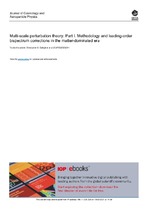Multi-scale perturbation theory. Part I. Methodology and leading-order bispectrum corrections in the matter-dominated era
Date
2020Author
Clarksona, Chris
Gallagher, Christopher S.
Clifton, Timothy
Metadata
Show full item recordAbstract
Two-parameter perturbation theory is a scheme tailor-made to consistently include nonlinear density contrasts on small scales (< 100 Mpc), whilst retaining a traditional
approach to cosmological perturbations in the long-wavelength universe. In this paper we
study the solutions that arise from this theory in a spatially-flat dust-filled cosmology, and
what these imply for the bispectrum of matter. This is achieved by using Newtonian perturbation theory to model the gravitational fields of nonlinear structures in the quasi-linear
regime, and then using the resulting solutions as source terms for the cosmological equations.
We find that our approach results in the leading-order part of the cosmological gravitational
potentials being identical to those that result from standard cosmological perturbation theory
at second-order, while the dark matter bispectrum itself yields some differences on Hubble
scales. This demonstrates that our approach is sufficient to capture most leading-order relativistic effects, but within a framework that is far easier to generalize. We expect this latter
property to be particularly useful for calculating leading-order relativistic corrections to the
matter power spectrum, as well as for deriving predictions for relativistic effects in alternative
theories of gravity.

